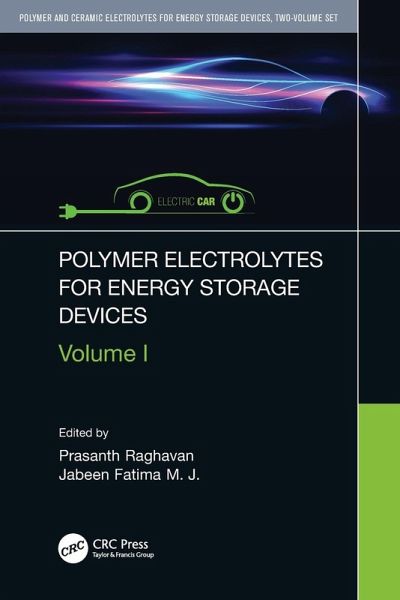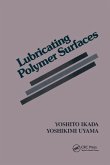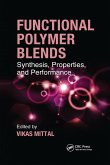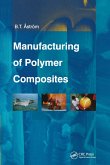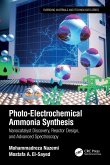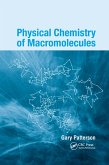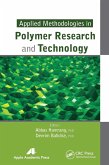Polymer Electrolytes for Energy Storage Devices
Herausgeber: Raghavan, Prasanth; Fatima M J, Jabeen
Polymer Electrolytes for Energy Storage Devices
Herausgeber: Raghavan, Prasanth; Fatima M J, Jabeen
- Broschiertes Buch
- Merkliste
- Auf die Merkliste
- Bewerten Bewerten
- Teilen
- Produkt teilen
- Produkterinnerung
- Produkterinnerung
Polymer Electrolytes for Energy Storage Devices offers a detailed explanation of recent progress and challenges in polymer electrolyte research for energy storage devices. The influence of these electrolyte properties on the performance of different energy storage devices is discussed in detail.
Andere Kunden interessierten sich auch für
![Lubricating Polymer Surfaces Lubricating Polymer Surfaces]() Yoshikimi UyamaLubricating Polymer Surfaces94,99 €
Yoshikimi UyamaLubricating Polymer Surfaces94,99 €![Functional Polymer Blends Functional Polymer Blends]() Functional Polymer Blends139,99 €
Functional Polymer Blends139,99 €![Manufacturing of Polymer Composites Manufacturing of Polymer Composites]() B Tomas AstromManufacturing of Polymer Composites159,99 €
B Tomas AstromManufacturing of Polymer Composites159,99 €![Photo-Electrochemical Ammonia Synthesis Photo-Electrochemical Ammonia Synthesis]() Mohammadreza NazemiPhoto-Electrochemical Ammonia Synthesis114,99 €
Mohammadreza NazemiPhoto-Electrochemical Ammonia Synthesis114,99 €![Physical Chemistry of Macromolecules Physical Chemistry of Macromolecules]() Gary PattersonPhysical Chemistry of Macromolecules95,99 €
Gary PattersonPhysical Chemistry of Macromolecules95,99 €![Applied Methodologies in Polymer Research and Technology Applied Methodologies in Polymer Research and Technology]() Applied Methodologies in Polymer Research and Technology112,99 €
Applied Methodologies in Polymer Research and Technology112,99 €![The Fractal Physical Chemistry of Polymer Solutions and Melts The Fractal Physical Chemistry of Polymer Solutions and Melts]() The Fractal Physical Chemistry of Polymer Solutions and Melts112,99 €
The Fractal Physical Chemistry of Polymer Solutions and Melts112,99 €-
-
-
Polymer Electrolytes for Energy Storage Devices offers a detailed explanation of recent progress and challenges in polymer electrolyte research for energy storage devices. The influence of these electrolyte properties on the performance of different energy storage devices is discussed in detail.
Hinweis: Dieser Artikel kann nur an eine deutsche Lieferadresse ausgeliefert werden.
Hinweis: Dieser Artikel kann nur an eine deutsche Lieferadresse ausgeliefert werden.
Produktdetails
- Produktdetails
- Verlag: Taylor & Francis Ltd (Sales)
- Seitenzahl: 281
- Erscheinungstermin: 7. Oktober 2024
- Englisch
- Abmessung: 234mm x 156mm x 16mm
- Gewicht: 426g
- ISBN-13: 9780367701536
- ISBN-10: 0367701537
- Artikelnr.: 71561857
- Herstellerkennzeichnung
- Libri GmbH
- Europaallee 1
- 36244 Bad Hersfeld
- gpsr@libri.de
- Verlag: Taylor & Francis Ltd (Sales)
- Seitenzahl: 281
- Erscheinungstermin: 7. Oktober 2024
- Englisch
- Abmessung: 234mm x 156mm x 16mm
- Gewicht: 426g
- ISBN-13: 9780367701536
- ISBN-10: 0367701537
- Artikelnr.: 71561857
- Herstellerkennzeichnung
- Libri GmbH
- Europaallee 1
- 36244 Bad Hersfeld
- gpsr@libri.de
Dr. Prasanth Raghavan, Professor, at Department of Polymer Science and Rubber Technology, Cochin University of Science and Technology (CUSAT), and Visiting Professor at Department of Materials Engineering and Convergence Technology, Gyeongsang National University, Republic of Korea. He received his PhD in Engineering under the guidance of Prof. Jou-Hyeon Ahn, from Department of Chemical and Biological Engineering, Geyongsang National University, Republic of Korea, in 2009, under prestigious Brain Korea (BK21) Fellowship. He completed his B.Tech and M.Tech from CUSAT, India. After a couple of years of attachment stint as Project Scientist at Indian Institute of Technology (IIT-D), New Delhi, he moved to abroad for his PhD studies in 2007. His PhD research was focused on fabrication and investigation of nanoscale fibrous electrolytes for high performance energy storage devices. He completed his Engineering doctoral degree in less than three years and still it's an unbroken record in Republic of Korea. After the PhD, Dr. Prasanth joined as Research Scientist at Nanyang Technological University (NTU), Singapore in collaboration with Energy Research Institute at NTU (ERI@N) and TUM CREATE, a joint electromobility research centre between Germany's Technische Universität München (TUM) and NTU, where he was working with Prof. Rachid Yazami, the one who has successfully introduced graphitic carbon as anode for commercial lithium ion batteries, and received Draper Prize along with the Nobel Laurates Prof. J. B. Goodenough and Prof. Akira Yoshino. After four years in Singapore, Dr. Prasanth moved to Rice University, USA as Research Scientist where he was working with Prof. Pulickal M Ajayan, the co-inventor of Carbon Nanotubes, and lucky to work with 2019 Chemistry Nobel laurate Prof. J. B. Goodenough. Dr. Prasanth was selected for Brain Korea Fellowship (2007), SAGE Research Foundation Fellowship, Brazil (2009), Estonian Science Foundation Fellowship, European Science Foundation Fellowship (2010), Faculty Recharge, UGC (2015) etc. He received many international awards including Young Scientist award, Korean Electrochemical Society (2009), selected for Bharat Vikas Yuva Ratna Award, (2016) etc. He developed many products such as high performance breaking parachute, flex wheels for space shuttles, high performance lithium ion batteries for leading portable electronic device and automobile industries etc. He has a general research interest in polymer synthesis and processing, nanomaterials, green/nanocomposites, and electrospinning. His current research focused on nanoscale materials and polymer composites for printed and light weight charge storage solutions including high temperature supercapacitors and batteries. He have published a good number of research papers and book/book chapters in high impact factor journals and have more than 5000 citation and h-index of 45 plus. Apart from science and technology, Dr. Prasanth is a poet, activist and a columnist in online portals and printed media. Dr. Jabeen Fatima M. J is a research scientist at Materials Science and NanoEngineering Lab (MSNE Lab), Department of Polymer Science and Rubber Technology (PSRT), Cochin University of Science and Technology (CUSAT), India. Before joining MSNE Lab, she was working as a tentative Assistant Professor at Department of NanoScience and Technology, University of Calicut, India. She received her Ph.D in Nanoscience and Technology from University of Calicut in 2016, India, with prestigious National Fellowship JRF/SRF from Council of Scientific and Industrial Research (CSIR), under Ministry of Science and Technology, Government of India. Her research area was focused on synthesis of nanostructures for photoelectrodes for photovoltaic applications, energy storage devices, photoelectrochemical water splitting, catalysis etc. She received her MS degree in Applied Chemistry (University First Rank) after receiving her B.Sc degree in Chemistry from Mahatma Gandhi University (MGU), Kottayam, India. She received many prestigious fellowships like Junior/Senior Research fellowship (JRF/SRF) from Centre for Science and Research, Department of Science and Technology, Ministry of India, Post-doctoral/research scientist fellowship from Kerala State Council for Science, Technology and Environment (KSCSTE), InSc research excellence award, etc. She has published a good number of full length research articles in peer reviewed international journals and book chapters with international publishers. She is serving as reviewer for many STM journals publishing by Wiley International, Elsevier, Springer Nature etc. Her current area of interest includes the development of flexible and free standing electrodes for printable and stretchable energy storage solutions and development of novel nanostructured materials and ternary composite electrodes and electrolytes for sustainable energy applications like super capacitors, fuel cells and lithium ion batteries.
1. Electrochemical Energy Storage Systems: The State-of-the-Art Energy
Technologies. 2. The Great Nobel Prize History of Lithium Ion Batteries:
The New Era of Electrochemical Energy Storage Solutions. 3. Polyethylene
Oxide (PEO) based Solid Polymer Electrolytes for Rechargeable Lithium Ion
Batteries. 4. Polymer Nanocomposites based Solid State Electrolytes for
Lithium Ion Batteries. 5. Poly(vinylidene fluoride) (PVdF) based Polymer
Electrolytes for Lithium Ion Batteries. 6. Poly(vinylidene
fluoride-co-hexafluoropropylene) (PVdF-co-HFP) based Gel Polymer
Electrolyte for Lithium Ion Batteries. 7. Polyacrylonitrile (PAN) based
Polymer Electrolyte for Lithium Ion Batteries. 8. Polymer Blend
Electrolytes for High Performance Lithium Ion Batteries. 9. Polymer Clay
Nanocomposite Electrolyte for Lithium Ion Batteries. 10. Polymer Silica
Nanocomposite Gel Electrolytes for Lithium Ion Batteries. 11. Polymer-ionic
Liquid Gel Electrolyte for Lithium-Ion Batteries. 12. Biopolymer
Electrolytes for Energy Storage Applications.
Technologies. 2. The Great Nobel Prize History of Lithium Ion Batteries:
The New Era of Electrochemical Energy Storage Solutions. 3. Polyethylene
Oxide (PEO) based Solid Polymer Electrolytes for Rechargeable Lithium Ion
Batteries. 4. Polymer Nanocomposites based Solid State Electrolytes for
Lithium Ion Batteries. 5. Poly(vinylidene fluoride) (PVdF) based Polymer
Electrolytes for Lithium Ion Batteries. 6. Poly(vinylidene
fluoride-co-hexafluoropropylene) (PVdF-co-HFP) based Gel Polymer
Electrolyte for Lithium Ion Batteries. 7. Polyacrylonitrile (PAN) based
Polymer Electrolyte for Lithium Ion Batteries. 8. Polymer Blend
Electrolytes for High Performance Lithium Ion Batteries. 9. Polymer Clay
Nanocomposite Electrolyte for Lithium Ion Batteries. 10. Polymer Silica
Nanocomposite Gel Electrolytes for Lithium Ion Batteries. 11. Polymer-ionic
Liquid Gel Electrolyte for Lithium-Ion Batteries. 12. Biopolymer
Electrolytes for Energy Storage Applications.
1. Electrochemical Energy Storage Systems: The State-of-the-Art Energy
Technologies. 2. The Great Nobel Prize History of Lithium Ion Batteries:
The New Era of Electrochemical Energy Storage Solutions. 3. Polyethylene
Oxide (PEO) based Solid Polymer Electrolytes for Rechargeable Lithium Ion
Batteries. 4. Polymer Nanocomposites based Solid State Electrolytes for
Lithium Ion Batteries. 5. Poly(vinylidene fluoride) (PVdF) based Polymer
Electrolytes for Lithium Ion Batteries. 6. Poly(vinylidene
fluoride-co-hexafluoropropylene) (PVdF-co-HFP) based Gel Polymer
Electrolyte for Lithium Ion Batteries. 7. Polyacrylonitrile (PAN) based
Polymer Electrolyte for Lithium Ion Batteries. 8. Polymer Blend
Electrolytes for High Performance Lithium Ion Batteries. 9. Polymer Clay
Nanocomposite Electrolyte for Lithium Ion Batteries. 10. Polymer Silica
Nanocomposite Gel Electrolytes for Lithium Ion Batteries. 11. Polymer-ionic
Liquid Gel Electrolyte for Lithium-Ion Batteries. 12. Biopolymer
Electrolytes for Energy Storage Applications.
Technologies. 2. The Great Nobel Prize History of Lithium Ion Batteries:
The New Era of Electrochemical Energy Storage Solutions. 3. Polyethylene
Oxide (PEO) based Solid Polymer Electrolytes for Rechargeable Lithium Ion
Batteries. 4. Polymer Nanocomposites based Solid State Electrolytes for
Lithium Ion Batteries. 5. Poly(vinylidene fluoride) (PVdF) based Polymer
Electrolytes for Lithium Ion Batteries. 6. Poly(vinylidene
fluoride-co-hexafluoropropylene) (PVdF-co-HFP) based Gel Polymer
Electrolyte for Lithium Ion Batteries. 7. Polyacrylonitrile (PAN) based
Polymer Electrolyte for Lithium Ion Batteries. 8. Polymer Blend
Electrolytes for High Performance Lithium Ion Batteries. 9. Polymer Clay
Nanocomposite Electrolyte for Lithium Ion Batteries. 10. Polymer Silica
Nanocomposite Gel Electrolytes for Lithium Ion Batteries. 11. Polymer-ionic
Liquid Gel Electrolyte for Lithium-Ion Batteries. 12. Biopolymer
Electrolytes for Energy Storage Applications.

